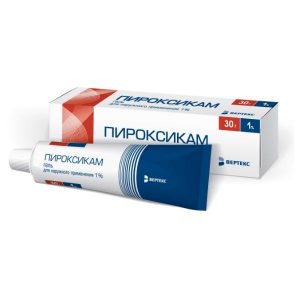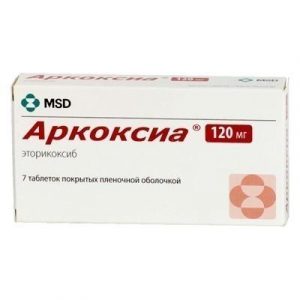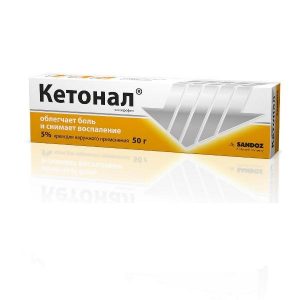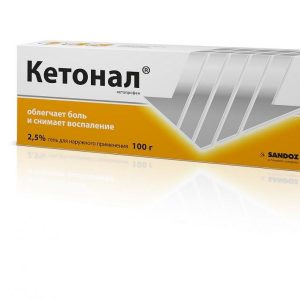Description
Dosage
Intramuscular solution
Packaging
5 ampoules
Pharmacological action
Movasin is a non-steroidal anti-inflammatory drug with analgesic, anti-inflammatory and antipyretic effects. The anti-inflammatory effect is associated with inhibition of the enzymatic activity of cyclooxygenase-2 (COX-2), which is involved in the biosynthesis of prostaglandins in the area of inflammation. To a lesser extent, meloxicam acts on cyclooxygenase-1 (COX-1), which is involved in the synthesis of prostaglandin, which protects the mucous membrane of the gastrointestinal tract (GIT) and is involved in the regulation of blood flow in the kidneys.
Indications
Symptomatic treatment of osteoarthrosis
Symptomatic treatment of rheumatoid arthritis
Symptomatic treatment of ankylosing spondylitis (ankylosing spondylitis).
Contraindications
hypersensitivity to the active substance or auxiliary components of
is contraindicated in the period after coronary artery bypass grafting
decompensated heart failure
complete or incomplete combination of bronchial asthma, recurrent nasal necrosis of the mucosal side of the patient, and other anti-inflammatory drugs (NSAIDs) (including history)
erosive and ulcerative changes in the mucous membrane and the stomach and duodenum 12, active gastrointestinal bleeding
exacerbation of inflammatory bowel disease (ulcerative colitis, Crohn’s disease)
cerebrovascular bleeding or other bleeding
severe liver failure or active liver disease
severe renal failure in patients not undergoing dialysis (less than clearance) ml / min), progressive kidney disease, including confirmed hyperkalemia
pregnancy progressive kidney disease including confirmed hyperkalemia
pregnancy progressive kidney disease including confirmed hyperkalemia
pregnancy, the period of breastfeeding
children under 18 years of age.
Special instructions
Caution should be exercised when using the drug in patients with a history of gastric and duodenal ulcer, as well as in patients undergoing anticoagulant therapy. In such patients, the risk of erosive and ulcerative diseases of the gastrointestinal tract is increased.
Caution should be exercised and renal function indicators monitored when using the drug in elderly patients, in patients with chronic heart failure with clinical manifestations, in patients with cirrhosis, as well as in patients with hypovolemia as a result of surgical interventions.
In patients with renal failure, if CC more than 30 ml / min, dosage adjustment is not required.
In patients on dialysis, the dosage of the drug should not exceed 7.5 mg / day.
Patients taking both diuretics and meloxicam should take enough fluids.
If an allergic reaction occurs during treatment (itching, skin rash, urticaria, photosensitivity), you should consult a doctor to decide whether to stop taking the drug.
Meloxicam, like other NSAIDs, can mask the symptoms of infectious diseases.
The use of meloxicam, as well as other drugs that block the synthesis of prostaglandins, can affect fertility, therefore not recommended for women planning a pregnancy.
Composition
1 ml contains:
m active substance: 10 mg sodium chloride active substance: 10 mg glycine, glycofurfural (tetraglycol), poloxamer 188, meglumine (meglumine), sodium hydroxide, water for injection.
Dosage and Administration
Intramuscularly. Intramuscular administration of the drug Movasin is indicated only during the first 2-3 days. Further treatment is continued with the use of oral forms (tablets).
The recommended dose is 7.5 mg or 15 mg 1 time / day, depending on the intensity of the pain and the severity of the inflammatory process.
The drug is administered deeply intramuscularly. Intravenous administration of the drug is prohibited!
In patients with an increased risk of adverse reactions, the daily dose should not exceed 7.5 mg.
In patients with end-stage renal failure undergoing hemodialysis, the dose should not exceed 7.5 mg. In patients with small or moderate impaired renal function (CC more than 30 ml / min), the dose should not exceed 7.5 mg.
Dosage regimen of the drug for intramuscular injection in children and adolescents is not defined, this dosage form can be used only in adult patients. The maximum recommended daily dose is 15 mg.
With the combined use of various dosage forms of the drug, its maximum daily dose in tablets, suppositories and as a solution for injection is 15 mg.
Side effects of
From the digestive system: more than 1% – dyspepsia, including nausea, vomiting, abdominal pain, constipation, flatulence, diarrhea 0.1-1% – a transient increase in the activity of hepatic transaminases, hyperbilirubinemia, belching, esophagitis, gastroduodenal ulcer, gastrointestinal bleeding (including hidden), stomatitis less than 0, 1% – gastrointestinal perforation, colitis, hepatitis, gastritis.
From the hematopoietic system: more than 1% – anemia 0.1-1% – change in blood count, including leukopenia, thrombocytopenia.
From the skin: more than 1% – itching, skin rash 0.1-1% – urticaria less than 0.1% – photosensitivity, bullous rashes, erythema multiforme, incl. Stevens-Johnson syndrome, toxic epidermal necrolysis.
From the respiratory system: less than 0.1% – bronchospasm.
From the central nervous system (CNS): more than 1% – dizziness, headache 0.1-1% – vertigo, tinnitus, drowsiness less than 0.1% – confusion, disorientation, emotional lability.
From the cardiovascular system (CCC): more than 1% – peripheral edema 0.1-1% – increased blood pressure (BP), palpitations, flushing of the face.
From the urinary system: 0.1-1% – hypercreatininemia and / or increased urea in the blood serum of less than 0.1% – acute renal failure, no connection with meloxicam has been established – interstitial nephritis, albuminuria, hematuria.
On the part of the sensory organs: less than 0.1% – conjunctivitis, visual impairment, including blurred vision.
Allergic reactions: less than 0.1% – angioedema, anaphylactic / anaphylactoid reactions.
Local reactions: more than 1% – swelling at the injection site less than 1% – pain at the injection site
Drug interaction
When taken with other NSAIDs (as well as with acetylsalicylic acid), the risk of erosive ulcerative lesions and bleeding from the gastrointestinal tract increases.
With simultaneous use with antihypertensive drugs, a decrease in the effectiveness of the action of the latter is possible.
With simultaneous use with lithium preparations, it is possible to develop cumulation of lithium and increase its toxic effect (it is recommended to control the concentration of lithium in the blood).
With simultaneous use with methotrexate, the side effect of the latter on the hematopoietic system is enhanced (the risk of anemia and leukopenia, periodic monitoring of the general blood test is indicated).
With simultaneous use with diuretics and with cyclosporine, the risk of developing renal failure increases.
With simultaneous use with intrauterine contraceptives, the effectiveness of the latter may be reduced.
When used simultaneously with anticoagulants (heparin, ticlopidine, warfarin), antiplatelet agents (acetylsalicylic acid, clopidogrel), as well as with fibrinolytic drugs (streptokinase, fibrinolysin) increases the risk of bleeding (requires periodic monitoring of blood coagulation).
Concomitant use with selective serotonin reuptake inhibitors increases the risk of gastrointestinal bleeding.
Overdose
Symptoms: impaired consciousness, nausea, vomiting, epigastric pain, gastrointestinal bleeding, acute renal failure, liver failure, respiratory arrest, asystole.
Treatment: there is no specific antidote for symptomatic therapy. Forced diuresis, alkalization of urine, hemodialysis are ineffective due to the high connection of the drug with blood proteins.
Storage Conditions
In a dry, dark place at a temperature not exceeding 30 ° C.
Term hodnosty
3 years
active substance
Meloxicam
Conditions granted through pharmacies
In retseptu
Dosage form
solution for injection
Synthesis, Russian




